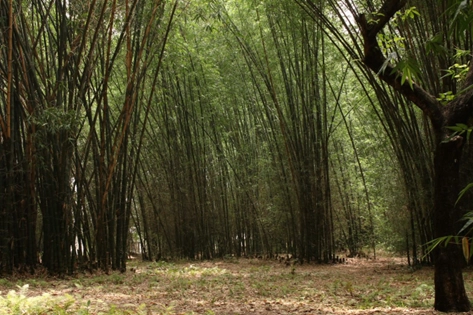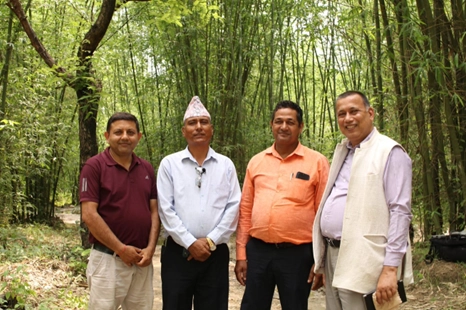In the image: Mr. Prem Giri: Ex-Nepalese MP, Abhiyan Nepal board member, in the Ganjabaari Bamboo Forest along with his colleagues.
Introduction: A transformative journey in bamboo sheltering began
Amidst Nepal’s majestic landscapes, a transformative journey unfolded when Habitat for Humanity Nepal, inspired by a vision to shelter vulnerable families, found a powerful ally in bamboo, a bond that prospered in sustainable development. This extraordinary partnership led to the construction of Habitat for Humanity Nepal’s very first bamboo home in 2005 A.D.
Partnering for a Greener Tomorrow:
Habitat for Humanity Nepal harnessed the exceptional potential of bamboo as an eco-friendly, earthquake-resistant building material and spearheaded the construction of bamboo homes for those in need. Today, Habitat Nepal’s endeavor extend beyond housing nurturing partnerships to cultivate a flourishing bamboo ecosystem.
Habitat for Humanity Netherlands, Habitat Nepal, and Abhiyan Nepal Join Hands:
In the year 2007 A.D., a trailblazing collaboration that ignited between Habitat for Humanity Nepal and Abhiyan Nepal, a grassroots organization championing farmers’ and landless people’s rights in Eastern Nepal started a bamboo forest plantation in the seemingly barren Ganjabaari, defying skepticism and paving the way for transformation. This ambitious initiative received vital support and funding from Habitat for Humanity Netherlands, fueling the dream of a greener and sustainable future.
Sowing the Seeds of a Green Revolution:
Investing in bamboo cultivation has yielded incredible results. The once arid land now blossoms into a stunning bamboo forest in the Ganjabaari area, where the bamboo plantation was accomplished through a collaboration between Habitat for Humanity Netherlands, Habitat Nepal, and Abhiyan Nepal. This breathtaking transformation showcases nature’s resilience and the power of working together.
Bamboo has transcended its role as a mere building material in the region. It has captured the hearts of builders and garnered high demand across various bamboo product industries.
Nestled beside tranquil riverbanks, the bamboo plantation stands as a living testament in Ganjabaari to the profound impact of sustainable practices on the environment. As the bamboo shoots reach for the sky, they seem to dance in perfect harmony with the gentle breeze, whispering stories of hope and rejuvenation.
The local community’s acceptance and embrace of bamboo as more than just a construction material has been nothing short of remarkable. From traditional builders to modern architects, the area around Ganjabaari now recognizes the unparalleled versatility and resilience of this magnificent plant. The once-skeptical eyes have been opened to the countless possibilities that bamboo offers, and it has now become the heartbeat of the region. This word of mouth has also been done by the members of Abhiyan Nepal.

Impact and Resounding Testimonials:
Amidst the captivating allure of the bamboo-inspired ecosystem, heartfelt admiration resounds in every voice. Prem Giri, a former parliamentarian and esteemed board member of Abhiyan Nepal, sings praises of Habitat for Humanity’s far-reaching influence. He says, “The thriving bamboo forests have become a source of sustenance not only for humanity but also for the wondrous creatures of nature, a living testament to the profound impact that collaboration and compassion can have, rippling through the very fabric of life.” He further adds, When in parliament, I also advocated for the usage of bamboo in day-to-day life and to build policy around the sustainable usage of bamboo by the government of Nepal.
A Holistic Green Vision of Habitat for Humanity Nepal:
Habitat Nepal has embraced a holistic approach that extends beyond housing, shaping a future anchored in sustainability. By nurturing market incentives for bamboo products and offering technical expertise, it has ignited a green revolutionary transformation. Collaborating with organizations such as Green Bamboo in a Hilti-funded endeavor, tHabitat Nepal has empowered the private sector to cater to low-income and marginalized communities with exceptional bamboo housing solutions.
Beyond its role in constructing sturdy and earthquake-resistant homes, bamboo has sparked a revolution in the flourishing bamboo product industries. Artisans and craftsmen skillfully harness the innate beauty of the plant to craft an array of sustainable and climate-friendly products. From intricately woven furniture and durable household items to stylish accessories and eco-friendly packaging, the demand for bamboo products is surging, bringing newfound prosperity to local artisans as even shared by Abhiyan Nepal members. Abhiyan Nepal representatives happily share that the community people had also gotten skill-based training on making bamboo products in the past.
Now, Habitat Nepal’s focus on market systems involves supporting and facilitating the functioning of the bamboo market, engaging private bamboo entrepreneurs, producers’ groups, and other stakeholders such as the Government of Nepal, civil society organizations, bamboo homeowners, and skilled manpower trained in creating bamboo products and masons trained in building cement bamboo framed technology (CBFT) homes. Through collaborative efforts with donor partners, Habitat Nepal is working towards creating sustainable housing solutions with a strong commitment to environmental and climate harmony as well.
Conclusion: Cultivating a Flourishing Bamboo Ecosystem through Powerful Partnerships
Therefore, a symphony of transformation has reverberated in the Ganjabaari area of Jhapa, Nepal as Habitat for Humanity Netherlands, Habitat Nepal, and Abhiyan Nepal have nurtured a thriving bamboo ecosystem. Rooted in nature’s resilience, the bamboo revolution promises hope for a sustainable future. Each bamboo home built and every forest that flourishes speaks of an unwavering commitment, to building a greener, more compassionate world for generations to come.

